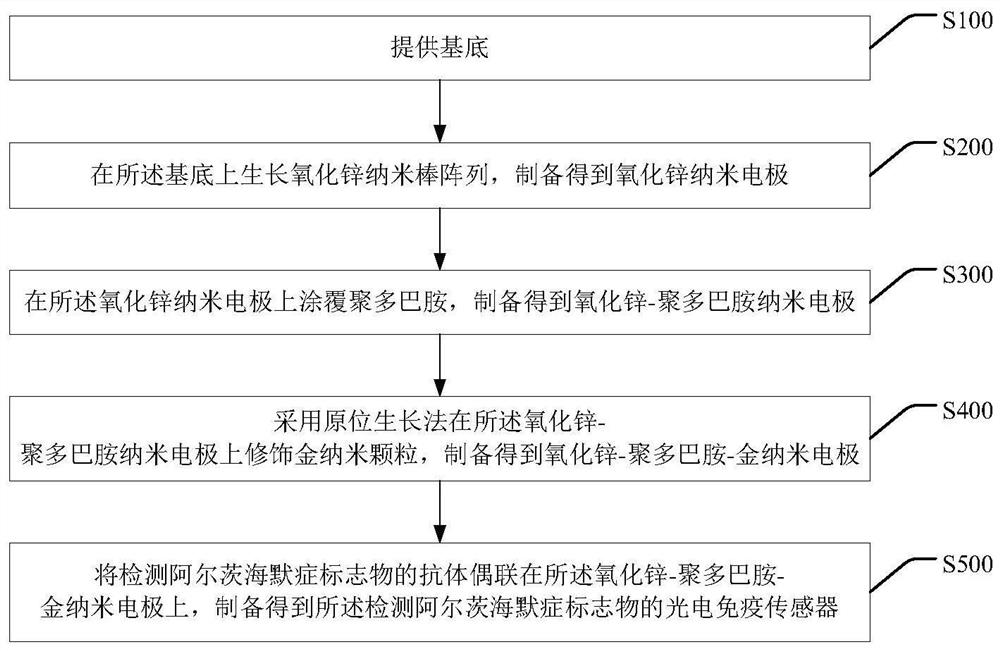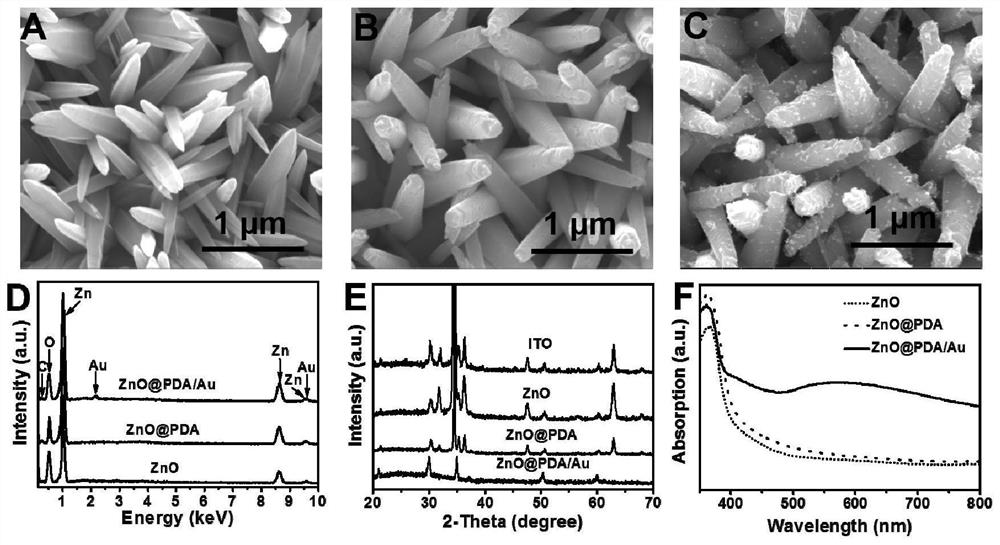Photoelectric immunosensor for detecting Alzheimer's disease marker as well as preparation method and application of photoelectric immunosensor
An Alzheimer's disease, immunosensor technology, applied in the field of biochemical sensing, can solve problems such as the limitation of the number of antibodies, and achieve the effects of promoting binding, improving separation efficiency, and improving production capacity
- Summary
- Abstract
- Description
- Claims
- Application Information
AI Technical Summary
Problems solved by technology
Method used
Image
Examples
Embodiment 1
[0096] Preparation of ZnO@PDA / Au electrode
[0097] 1. Growth of ZnO nanorod arrays on ITO substrates
[0098] First, a clean piece of ITO with a size of 2.5 cm × 1 cm was soaked in freshly prepared 5 mM KMnO 4 Solution, soak for 30min at room temperature. After thoroughly rinsing with deionized water, place the ITO conductive side down into the 3 ) 2 (0.1M), ammonium hydroxide (3% v / v) and ethylenediamine (1% v / v) in 10 mL of the precursor solution, and reacted in a water bath at 75° C. for 3 h. After the reaction was completed, the obtained ZnO electrode was rinsed with water, and then dried under a mild nitrogen flow for further use.
[0099] 2. Coating PDA on the ZnO electrode
[0100] The synthesized ZnO electrode was immersed in 20 mL Tris-HCl solution (10 mM, pH=8.5) containing 40 mg polydopamine, left at room temperature for 4 h, and then gently rinsed several times with deionized water. The obtained ZnO@PDA electrodes were stored below 4 °C for future use.
[0...
Embodiment 2
[0104] Characterization of ZnO@PDA / Au electrodes
[0105] The morphology, structure and composition of the ZnO@PDA / Au electrode prepared in Example 1 were tested
[0106] 1. Morphological characteristics of SEM detection electrodes
[0107] figure 2 A is the SEM image of the ZnO electrode. It can be seen from the figure that a large number of ZnO nanorods are grown on the ITO glass, with a length of about 1.2nm and a diameter of less than 200nm. The one-dimensional structure and large gaps of ZnO nanorods can provide high specific surface area, which is beneficial for light harvesting and further biomaterial assembly.
[0108] figure 2 B is the SEM image of the ZnO@PDA electrode. After being coated with PDA, the surface of the modified nanorods is rougher than that of the unmodified ZnO nanorods, indicating that PDA has successfully wrapped the ZnO nanorods to form a core / shell structure. While the original structure of ZnO nanorods remains unchanged.
[0109] figure ...
Embodiment 3
[0118] Photoelectrochemical and electrochemical properties of ZnO@PDA / Au electrode
[0119] The electrochemical behavior and photocurrent response of the ZnO@PDA / Au electrode prepared in Example 2 were tested by linear sweep voltammetry (LSV), transient photocurrent method and electrochemical impedance method (EIS).
[0120] 1. The applied voltage was between -0.05V and 0.3V, and the LSV curves of ZnO, ZnO@PDA and ZnO@PDA / Au electrodes under dark and light conditions were recorded. image 3 A shows the LSV curves of ZnO electrodes (a, d), ZnO@PDA electrodes (b, e) and ZnO@PDA / Au electrodes (c, f) under simulated sunlight irradiation. It can be seen from the figure that all the prepared photoelectrodes showed negligible currents under dark conditions. The current density of the ZnO@PDA / Au electrode is slightly higher than that of the other two electrodes, indicating that modifying ZnO with PDA and Au can improve its electrochemical performance. Under light conditions, using P...
PUM
| Property | Measurement | Unit |
|---|---|---|
| length | aaaaa | aaaaa |
| diameter | aaaaa | aaaaa |
Abstract
Description
Claims
Application Information
 Login to View More
Login to View More - R&D
- Intellectual Property
- Life Sciences
- Materials
- Tech Scout
- Unparalleled Data Quality
- Higher Quality Content
- 60% Fewer Hallucinations
Browse by: Latest US Patents, China's latest patents, Technical Efficacy Thesaurus, Application Domain, Technology Topic, Popular Technical Reports.
© 2025 PatSnap. All rights reserved.Legal|Privacy policy|Modern Slavery Act Transparency Statement|Sitemap|About US| Contact US: help@patsnap.com



